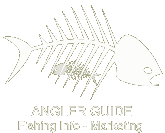 |  |
|
Navigation - Business - Great Lakes - Great Plains - Northeast - Northwest - Rocky Mountains - Southeast - Southwest - Technology - Trophy Catches
|
Cold-blooded fish are affected by water temperature, and as much as warm temperatures push them deep and discourage activity, cooler temperatures do just the opposite. The feeding urge is strong as fish eat to build up winter reserves. While baitfish populations are also abundant this time of year, anglers can easily take advantage of the increased feeding activity by being in the right place with the right lure. On a small lake or farm pond, small minnows and sunfish are on the diets of bass and crappie. The young-of-the-year baitfish have grown all summer, so anglers should match this hatch and use larger lures. Shallow-running crankbaits, spinnerbaits, plastic swimbaits, and jig-and-pig combos are good bets for largemouth bass. For crappie, itís hard to beat an eighth-ounce jig dressed with white marabou or a white plastic curly-tailed grub. For both species, fish near weeds and woody cover. Kansas reservoirs can provide outstanding white bass and wiper fishing in the fall. These open-water species are hunting for gizzard shad along main-lake points, underwater humps, and creek channel edges. Trolling silver, white or chartreuse crankbaits over structure is a good way to find fish. Or you can watch the birds. Gulls will flock and dive over the water where whites and wipers are feeding, picking up the scraps from the frenzied attacks. Boaters should approach the melees carefully to avoid spooking the shallow fish, then cast jigs, topwater plugs and spoons. Strikes are usually immediate, and the action can last for a few minutes or much longer, depending on the sizes of the schools. Shoreline anglers can enjoy excellent fishing this time of year by casting jigs and spoons on the windy side of the lake. The wave action provides excellent feeding conditions, concentrating shad and making them easy marks. A good method is to wade out on long, main-lake points or rip-rapped piers and cast into the wind. A 7-foot spinning rod with a light super line will allow long casts even in a stiff wind. This type of fishing can be very productive. Reservoir crappie can be caught from now through winter as they gather around standing trees and man-made brushpiles. KDWPT fisheries biologists spend a good portion of their time each winter and summer building fish-holding brushpiles. The weighted trees are often marked with buoys, but biologists will also provide GPS coordinates for those that arenít. Crappie anglers search out brush in 15-25 feet of water and fish jigs and minnows vertically just over the top or even in the brush. A light wind and stationary boat will be necessary to avoid snags, but big crappie fat from eating gizzard shad will be worth the trouble. When you add the pleasant weather, cooperative fish and low angler numbers together, it adds up to a great outdoor experience. Enjoy Kansas fall fishing.
Comments
«Back | News Home
| |||||||||||||||||||||||||||||||||||